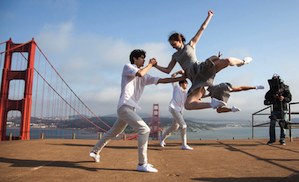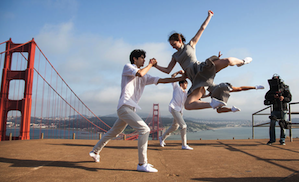
Although the four-day San Francisco Dance Film Festival, which Sunday wrapped up its 13th year, offered fine examples of live performance on film and video, it was the shorts — 1-1/2 to 16 minutes long — that most intrigued. Live onstage, they’d make no artistic sense at all. Presented in partnership with the International Music + Media Centre, in Europe, these are dances made for the screen, the objects of craft and care (and increasingly, computer wizardry). It’s hard to imagine that anyone, dance lover or no, wouldn’t drink them in.
We might point to this as yet another confirmation of the growing public awareness of the universality of the language of dance (not to mention the language of commerce, as in the high-rated "Dancing With the Stars" and "So You Think You Can Dance"). Or we might just be thankful for the level of artistry on show. This year 69 films were chosen from among 289 submissions for the festival, directed by its founder, Greta Schoenberg. The selections for the opener, Thursday at the Roxie Theater, were diverse, beautiful, antic, and pithy, not to hurl adjectives or anything; six of the 11 films were from the Bay Area.
Kate Duhamel’s 3-minute Aloft, by San Francisco choreographer Yuri Zhukov, featuring a half-dozen dancers in white and beige frolicking at Marin Headlands overlooking the Golden Gate Bridge to Steve Reich’s Four Sections I, was the perfect kickoff. Sunshine, That Bridge, puffy clouds, three women, three men, grand jetes, intense rhythmicity — you don’t need more. Though it was shot in 3D, this viewer found, at Saturday’s screening, that it seemed uncomfortably close.
San Francisco dance photographer RJ Muna’s Dervishes, at 3 minutes 17 seconds, casts a whirling spell. The action is mostly filmed from overhead; the lighting tends toward the kind of glam that makes Muna’s still photos so alluring. Women in white circle skirts edged with black spin in circles and move in circles, too, and the vertical seams of the concrete floor, viewed from overhead, emphasize the piece’s triply (and trippy) circular architecture. Josh Heineman composed.
Most, but not all, the shorts were modern dance. For ballet, there was Tiit Helimets’ and Austin Forbord’s compelling White, five minutes long, danced by Sarah van Patten. Helimets and van Patten are principal dancers with festival partner San Francisco Ballet. Without a program, most people probably wouldn’t recognize White as being about Helimets’ native Estonia being held captive, oppressed, and polluted by foreign cultures. Van Patten, exquisite in a snowy tutu and seemingly floating on pointe, traces, with her satin toe shoes extruding black ink, an image that when viewed from overhead becomes an eye of hope, a symbol of the Estonian people. Even without that knowledge, it was mesmerizing to see all this black stuff saturate a pristine pointe shoe and create a pattern on the white floor; at the end, the ballerina literally levitates — no other way to get out of that eye, it would seem, and a lovely sight.
Two local duets of different moods, the silly and charming Pedestrian Crossing (3 minutes), choreographed by Eric Garcia and Kat Cole for Detour Dance, and the 6-minute, calmly intense Veronica & Vincent, choreographed and directed by Amy Seiwert, reflect two relationships, both problematic and both in the outdoors, which adds its own tacit commentary. Pedestrian Crossing offers the happier dilemmas; Veronica & Vincent (danced by Brandon “Private” Freeman and Andrea Basile) is filled with regrets; both are eloquently choreographed and performed.
Three of the longer pieces, meaning between 10 and 16 minutes, were amazingly original. From Sweden, Outside In muses on filmmaking’s artifice; directors Tove Skeidsvoll and Petrus Sjovik place the exquisite white-clad contemporary dancer in a movie studio’s white, birch forest setting, her movements continually interrupted by intrusive black-clad production people, measuring and fussing. Ultimately, she can take no more; she escapes, out the door, to a wonderful — and private — snowscape. We can feel the fresh air and freedom. The Time it Takes, from the U.K., recorded in the Outer Hebrides, gives the sense of interrupting a novel. Compositionally, it’s stunning, with the dancers’ costumes accentuating and reflecting the saturated color of the glens, skies and water, and their movements leaving you wanting to know more. Katrina McPherson directed; the choreography is uncredited.
Out of Chicago comes Fanfare for Marching Band, a jaunty line-dancing trek through a park, a bank, a railway station and a supermarket by Mucca Pazza, “a circus punk marching band” choreographed by Peter Carpenter. Their quickstepping interruptions fail to stir the stock-still citizenry. This was intended to stand for the impact of the recession. Mucca Pazza could solve a recession, or at least eradicate depression, single-footedly. Ben Bernanke, send in the clowns!
Space permits only cursory mention of Saturday’s shorts, equally fine. Kate Duhamel scored another local triumph with Lion – Night and Day, a study in dark and light full of angles and virtuosity, danced and largely improvised by Garen Scribner and Sergio Benvindo, of the San Francisco Ballet and Zhukov Ballet respectively. Inmates Rising, a 3-minute, 48-second live recording of incarcerated men and women in a San Francisco jail in Debbie Allen’s choreography for the international One Billion Rising movement, against sexual oppression and violence, earlier this year. Cast testimony was as impassioned and powerful as the choreography; the project (with uncredited crew) has led to other dance-related activities in local jails.
The evening’s big event, not part of the competition, was the 3D version of Matthew Bourne’s Swan Lake, set to the Tchaikovsky score and best known for its gender-crashing swans. I never saw it onstage, but the movie makes me eager to. It was a wonderful example of the glories of dance on film: completely satisfying, hilarious, sensitive and gorgeous, not to mention outrageous. In the Delancey Screening Room, it seemed to fly off the screen. Filmed in 2011 at Sadlers’ Wells in London (and broadcast there by Sky TV), directed by Ross McGibbon, the 3D is sometimes as disconcerting as the plotline. What it does beautifully is limn Bourne’s choreography, particularly for the male swans in their feathered pantaloons, and bring home the energy — the sound picks up the dancers’ panting, the camera their sweat — as well as every nuanced move of Richard Winsor, superb as the Swan/Stranger. Bourne simultaneously plays tribute to, pokes fun at, and inverts aspects of the time-honored Petipa/Ivanov set pieces for corps and principals. What a treat to get a close-up of this mastermind’s gifts.

